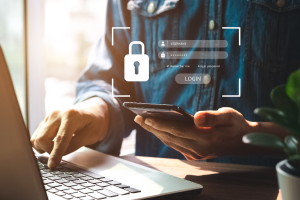Technological advancements continually emerge that make our lives easier. Right? As beneficial and convenient as emerging tech is, it can pose serious risks to our online safety and privacy—risks that you might find yourself ill-prepared to handle. In fact, according to our 2021 Consumer Security Mindset research, 45% of Canadian respondents don’t feel very confident about their ability to prevent a cyberattack and believe that they don’t have what they need to ward one-off.
With many of us turning to online platforms for things we used to do in-person, activities like banking, shopping, taxes, and more, the need for broader online privacy protection has never been greater. As we continue to integrate technology into our everyday lives, we must learn to recognize the risks they pose and understand how to safeguard our online security.
Telehealth
Telehealth visits have opened the door for many to get the medical care they need when visiting the doctor or going to the hospital isn’t feasible. Digital health platforms have demonstrated many benefits for optimizing time and cost efficiencies for both patients and providers, but at what cost?
Despite efforts to address barriers to virtual healthcare adoption, Canada currently lacks a national framework for governing virtual care. As a result, many healthcare providers are left to act on their best judgements regarding patient data interoperability across provinces and providers. The lack of a pan-Canadian governance framework also makes it difficult for digital health platforms to operate with the assurance of certain security protocols, leaving many of us to wonder how to best protect our data in the face of an ambiguous virtual healthcare system. The risk is made all the more severe when factoring in sensitive biometric data from monitoring devices that can be used for malicious purposes when in the hands of cyber attackers. Those of us who take advantage of digital health devices must understand how to secure our data privacy and control its usage to mitigate further risks.
The first line of defense to ensure your data remains protected is to understand the security policies put in place by your healthcare provider and any third-party digital platforms that they leverage. Additionally, you’ll want to ensure that your healthcare provider uses a telehealth platform that integrates data encryption. Take matters into your own hands by enabling two-factor authentication and use strong passwords across all devices and accounts. Using a VPN and running anti-malware and anti-virus scans can also mitigate the risk of security threats during telehealth visits and while using integrated medical devices.
Education
Student privacy is a top concern as households turn to remote learning. In a rush to optimize remote learning experiences in the face of a rapidly evolving digital landscape, many educators and remote learners may not realize the hazards that put student privacy at risk.
We’re almost a year into distance learning and schools have now adopted a range of technologies to optimize the digital classroom, including virtual learning platforms, holistic learning solutions, and even social media applications. However, many of these digital platforms are not designed for child usage, nor do they have privacy policies in place to ensure that the student data gathered is protected. Many learning platforms may even treat student data as consumer data, raising more red flags regarding student data privacy and compliance. Online learning has also garnered the attention of cybercriminals looking to exploit student data, resulting in online bullying, identity theft, and more.
For educators and parents alike, knowledge is the greatest asset to mitigating the risks of remote learning. IT teams and educators must understand the implications of the student data they collect, govern access to it, and control its usage to comply with child privacy regulations. Parents can take proper precautions by discussing the importance of privacy with their children. Keeping learning platforms up to date and monitoring their children to prevent them from downloading suspicious apps or straying to unknown websites are all ways to ensure safer remote learning environments.
Work
Remote work has become commonplace nowadays as more companies permit their employees to work from home long-term and, for some, permanently. Given the abrupt shift to remote workplaces in the past year, companies have found themselves severely unprepared to handle the security and logistical concerns that accompany a distributed remote workforce.
In a recent Fenwick poll among HR, privacy, and security professionals across industries, approximately 90% of employees now handle intellectual property, confidential, and personal information in their homes. Endpoint security, or the protection of end-user devices such as our laptops and mobile devices, poses more of a concern as employees trade in office networks for their in-home Wi-Fi. If these devices and networks are unsecured or if the data is not encrypted, employees run the risk of exposing sensitive information to hackers. A lack of proper employee security training opens additional opportunities for online threats to take advantage of unsuspecting victims through common phishing scams.
Those of us working from home can help ensure the safety of our company’s confidential information by boosting our awareness of security threats and prevention measures via company-mandated security trainings. Additionally, we can promote a safer remote working environment by practicing basic digital hygiene like keeping all devices and software up to date, using a VPN and a strong password across devices.
Fitness
With the limited availability of in-person exercise classes, many of us have turned to virtual fitness experiences to augment our personal health regimens. Some have even taken their fitness routines one step further to include and high-tech equipment like at-home spin bikes or other wearable devices to track and monitor progress.
Although these devices create a more engaging experience and connect users across the globe through online sharing, there are risks, too. Wearables and other devices embedded with sensors and software that collect and share data across an interconnected network are considered Internet of Things (IoT) technology. IoT devices don’t have the same stringent security protocols as laptops and mobile devices, making them more susceptible to cyberthreats.
To prevent cyber attackers from infiltrating IoT devices connected to your home network, start by securing your network router. Change the default name and password of your router so hackers can’t identify the make and model. Create an additional layer of security by enabling the highest level of encryption to secure your Wi-Fi network. We also suggest creating a guest network for your IoT devices so that even if someone does infiltrate your IoT device, they won’t be able to access other devices like laptops and mobile devices.
Personal Finances
Some of the platforms I use the most allow me to keep track of and manage my finances. Whether it’s my mobile banking app or taking advantage of online tax filing, there is such a convenience in having the ability to pay bills, deposit checks, and more, all with the devices I use every day. But many of us may not realize just how much trust we put into these platforms to protect our online privacy, especially when we don’t have a clear picture of who exactly is on the other end of our online transactions.
While recognizing the signs of online banking and tax-related fraud helps ease the burdens associated with these schemes, there are multiple steps users can take to prevent becoming a victim of these scams in the first place. If you receive a call regarding your taxes, make sure the caller is a CRA employee before handing over money or personal information on the phone. You can also double-check your tax account status and make sure the CRA has your current address and email. This will also show whether you owe a balance if a hacker does try to trick you into paying up. By being mindful of how cybercriminals take advantage of the platforms we use out of convenience, we can better protect against threats to our personal privacy.
Secure Your Technology to Secure Your Life
Digital devices are part of how we live our lives every day, whether we’re taking conference calls on our laptops, tracking the latest mile on our smartwatches, or banking on the go. Although our everyday digital devices make our lives that much more convenient, securing them makes our lives that much safer by minimizing online threats to ourselves and those around us. Safeguarding the digital platforms we use for work, school, fitness, you name it, is the first step to ensuring our private information remains just that—private.












